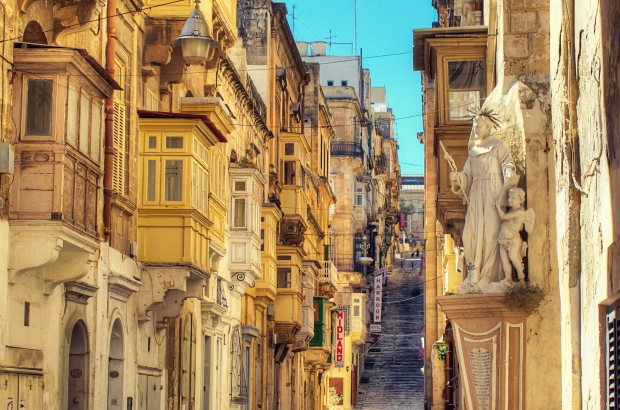- Daily & Weekly newsletters
- Buy & download The Bulletin
- Comment on our articles
Sun, sea and EU summits: The Bulletin's guide to Malta
Malta, a tiny group of Mediterranean islands – total population 420,000 – is a haven for history buffs. Its rich and varied heritage is a result of successive waves of colonisation. British rule for over 150 years means English is one of Malta’s official languages, while Italian and French are also widely spoken. Topping a list of 25 travel secrets in the latest Lonely Planet magazine, Valletta is described as one of Europe’s most beautiful capitals. It is preparing to host the European Capital of Culture in 2018.
Malta. Land of Sea
The title of this exhibition at Bozar (until 28 May) says it all. The history of EU’s smallest country has been dominated by a constant dialogue between land and sea. More than 60 artworks and objects present an interactive contemporary portrait of Malta. Organised around nine themes, curator Sandro Debono has gathered a highly diverse and unique collection of works, from present-day and historic navigation tools to prehistory architectural relics and large-scale paintings, including Caravaggio’s Portrait of Antonio Martelli, Knight of Malta and Turner’s The Malta Grand Harbor.
When to visit
The summer months maybe scorching, but off-season temperatures are more than comfortable for exploring. Outdoor activities such as hiking are an opportunity to visit unspoilt rural areas, which become much greener once the heat subsides, while diving is a year-round sport. Malta enjoys average highs of 23°C in October, falling to 18°C in December. There is a risk of rain in winter – February is the worst – but it tends towards flash floods rather than constant drizzle. Needless to say, flights and hotels also become more affordable. There are nine flights a week with Air Malta and daily flights with Ryanair, both from Brussels National. Car rental is recommended for getting around, as public transport can be slow.
What to see
Among Valletta’s historical gems is Saint John’s Co-Cathedral, built in the 16th century by the Knights of Malta. It’s said to resemble the Maltese people, in that you shouldn’t be deceived by a somewhat ordinary exterior, as many beautiful treasures lie inside. As far as the cathedral is concerned, these include Caravaggio’s painting of the Beheading of Saint John. Other traces of the knights can be seen in their fortified city perched on a high rock above the harbour. Contrasting with these ancient stones are a series of new structures by architect Renzo Piano, whose overhaul of the capital includes a new parliament and an outdoor opera house. The old capital is Mdina, a Unesco world heritage city near the centre of the island. Known as the silent city, its fortifications are one of the finest examples of medieval and baroque architecture in Europe. Within walking distance is Rabat, a typical working town. Its chief attractions are the Grotto of Saint Paul and its Roman villa and catacombs.
Gozo
Step back in time and enjoy the tranquillity and ancient temples of Malta’s second island, a half-hour ferry trip from the port of Cirkewwa, and home to some of Europe’s best scuba diving. Its capital, Victoria, is known among locals as Rabat and is home to a 17th-century citadel offering panoramic views. Also near the centre, the Ggantika Temple is a breath-taking Neolithic site. Head west for the most spectacular stretch of coast, where you’ll find the Inland Sea, a cliff-surrounded lagoon linked to the open sea by a tunnel. Another limestone arch, the Azure Window, is at risk of collapsing into the sea. Along with the nearby Blue Hole, it is a diving hotspot, as is the south where one of Gozo’s many shipwrecks, the MV Karwela, was scuttled in 2006 to create a reef. Off the beaten track in the north is Wied Il-Ghasri, a stunning cove. Further along the coast lies Calypso’s Cave, immortalised in Homer’s Odyssey and located next to the sandy beach of Ramla Bay.
Sleep, eat & drink
Valletta is transforming its old townhouses into boutique hotels ahead of its year as capital of culture. Bigger hotels and international chains can be found in the resorts of Sliema, an old fishing village, and St Julians, once home to Maltese aristocracy. Alternatively, rural farmhouses offer accommodation. Maltese cuisine leans towards the rich and hearty, reflecting the country’s heritage with influences ranging from Mediterranean and North African to British. The national dish is a rabbit stew called fenkata, while a popular savoury snack is the mini cheesecake pastizzi. There are two types of native grapes, a white and a red, and local liqueurs are flavoured with herbs, pomegranate, cactus fruit, carob and various fruits. There is also a good selection of olive oils, as a burgeoning industry promotes the nation’s indigenous white olive.
This article was first published in Expat Time autumn 2016









